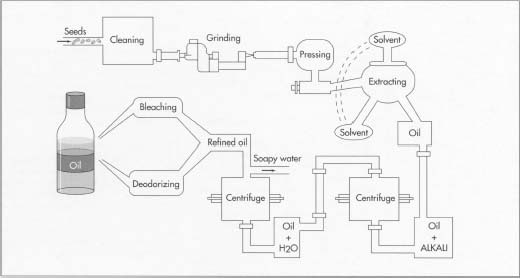
oil manufacturing process
Oil Manufacturing Process
Vegetable oil manufacturing process is a complicated oil manufacturing process. Different raw material has its different processing way, but generally speaking, oils are being processed by grinding, pressing or by solvent extraction and refining of the raw materials.
Oil Manufacturing Process Flowchart

Detailed Manufacturing Process for Vegetable Oil
Raw Material Pretreatment: In the entire oil manufacturing process, first thing for you to do is to ready the raw materials. The seeds ought to be dehulled, deskinned, or else removed of all external material. The stripped seeds or nuts are then ground into coarse meal to provide more surface area to be pressed. Then heat the meal before extracting. While the procedure allows more oil to be pressed out, more impurities are also pressed out with the oil, and these must be removed before the oil can be deemed edible.
Mechanical Oil Extraction: The heated meal is then fed continuously into an oil press machine, which increases the pressure progressively as the meal passes through a slotted barrel. Pressure generally increases from 68,950 to 20,6850 kilopascals since the oil is pressed right out of the slots in the barrel, where it could be recovered.
Solvent Extraction: High oil bearing seeds are usually not pressed at all before solvent extraction, because they have relatively little oil, but most oil seeds with more oil are pressed and solvent-treated. As soon as the initial oil has been recovered from the screw press, the oil cake staying in the press is processed by solvent extraction to get the utmost yield. In the vegetable oil manufacturing process, ninety percent of the solvent keeping the extracted oil simply evaporates, and, as it does, it is collected for reuse. The rest is retrieved with the use of a stripping column. The oil is boiled by steam, and the lighter hexane floats upward. As it condenses, it, too, is collected.
Vegetable Oil Refining: Oil refining is the one other important process in the oil manufacturing process, but it is optional. If you make oil for biodiesel use, this process could be omitted. The oil is refined to take out color, odor, and bitterness. Oils are also degummed at this time by treating them with water heated to between 188 and 206 degrees Fahrenheit (85 and 95 degrees Celsius), steam, or water with acid. The gums, most of which are phosphatides, precipitate out, and the dregs are removed by centrifuge. Finally, the oil is deodorized. In this process, steam is passed over hot oil in a vacuum at between 440 and 485 degrees Fahrenheit (225 and 250 degrees Celsius), thus allowing the volatile taste and odor components to distill from the oil.
If you're keen on the oil manufacturing process either for vegetable oil or edible oil, you will need to e-mail us as soon as possible and you may never regret doing it.

